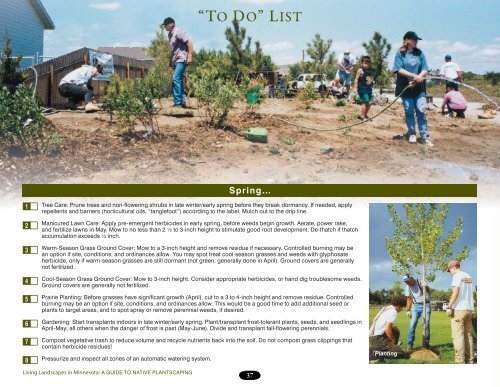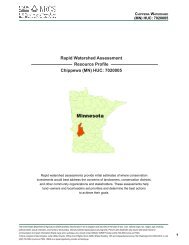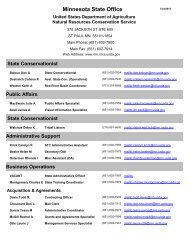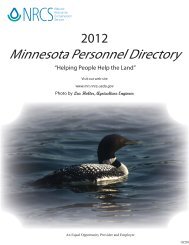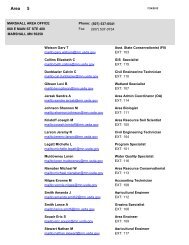Living Landscapes in Minnesota: - Minnesota NRCS - US ...
Living Landscapes in Minnesota: - Minnesota NRCS - US ...
Living Landscapes in Minnesota: - Minnesota NRCS - US ...
You also want an ePaper? Increase the reach of your titles
YUMPU automatically turns print PDFs into web optimized ePapers that Google loves.
1<br />
2<br />
3<br />
4<br />
5<br />
6<br />
7<br />
8<br />
Tree Care: Prune trees and non-flower<strong>in</strong>g shrubs <strong>in</strong> late w<strong>in</strong>ter/early spr<strong>in</strong>g before they break dormancy. If needed, apply<br />
repellents and barriers (horticultural oils, “tanglefoot”) accord<strong>in</strong>g to the label. Mulch out to the drip l<strong>in</strong>e.<br />
Manicured Lawn Care: Apply pre-emergent herbicides <strong>in</strong> early spr<strong>in</strong>g, before weeds beg<strong>in</strong> growth. Aerate, power rake,<br />
and fertilize lawns <strong>in</strong> May. Mow to no less than 2 ½ to 3-<strong>in</strong>ch height to stimulate good root development. De-thatch if thatch<br />
accumulation exceeds ½ <strong>in</strong>ch.<br />
Warm-Season Grass Ground Cover: Mow to a 3-<strong>in</strong>ch height and remove residue if necessary. Controlled burn<strong>in</strong>g may be<br />
an option if site, conditions, and ord<strong>in</strong>ances allow. You may spot treat cool-season grasses and weeds with glyphosate<br />
herbicide, only if warm-season grasses are still dormant (not green, generally done <strong>in</strong> April). Ground covers are generally<br />
not fertilized.<br />
Cool-Season Grass Ground Cover: Mow to 3-<strong>in</strong>ch height. Consider appropriate herbicides, or hand dig troublesome weeds.<br />
Ground covers are generally not fertilized.<br />
Prairie Plant<strong>in</strong>g: Before grasses have significant growth (April), cut to a 3 to 4-<strong>in</strong>ch height and remove residue. Controlled<br />
burn<strong>in</strong>g may be an option if site, conditions, and ord<strong>in</strong>ances allow. This would be a good time to add additional seed or<br />
plants to target areas, and to spot spray or remove perennial weeds, if desired.<br />
Garden<strong>in</strong>g: Start transplants <strong>in</strong>doors <strong>in</strong> late w<strong>in</strong>ter/early spr<strong>in</strong>g. Plant/transplant frost-tolerant plants, seeds, and seedl<strong>in</strong>gs <strong>in</strong><br />
April-May; all others when the danger of frost is past (May-June). Divide and transplant fall-flower<strong>in</strong>g perennials.<br />
Compost vegetative trash to reduce volume and recycle nutrients back <strong>in</strong>to the soil. Do not compost grass clipp<strong>in</strong>gs that<br />
conta<strong>in</strong> herbicide residues!<br />
Pressurize and <strong>in</strong>spect all zones of an automatic water<strong>in</strong>g system.<br />
<strong>Liv<strong>in</strong>g</strong> <strong>Landscapes</strong> <strong>in</strong> M<strong>in</strong>nesota: A GUIDE TO NATIVE PLANTSCAPING<br />
“TO DO” LIST<br />
Spr<strong>in</strong>g…<br />
37<br />
Plant<strong>in</strong>g


